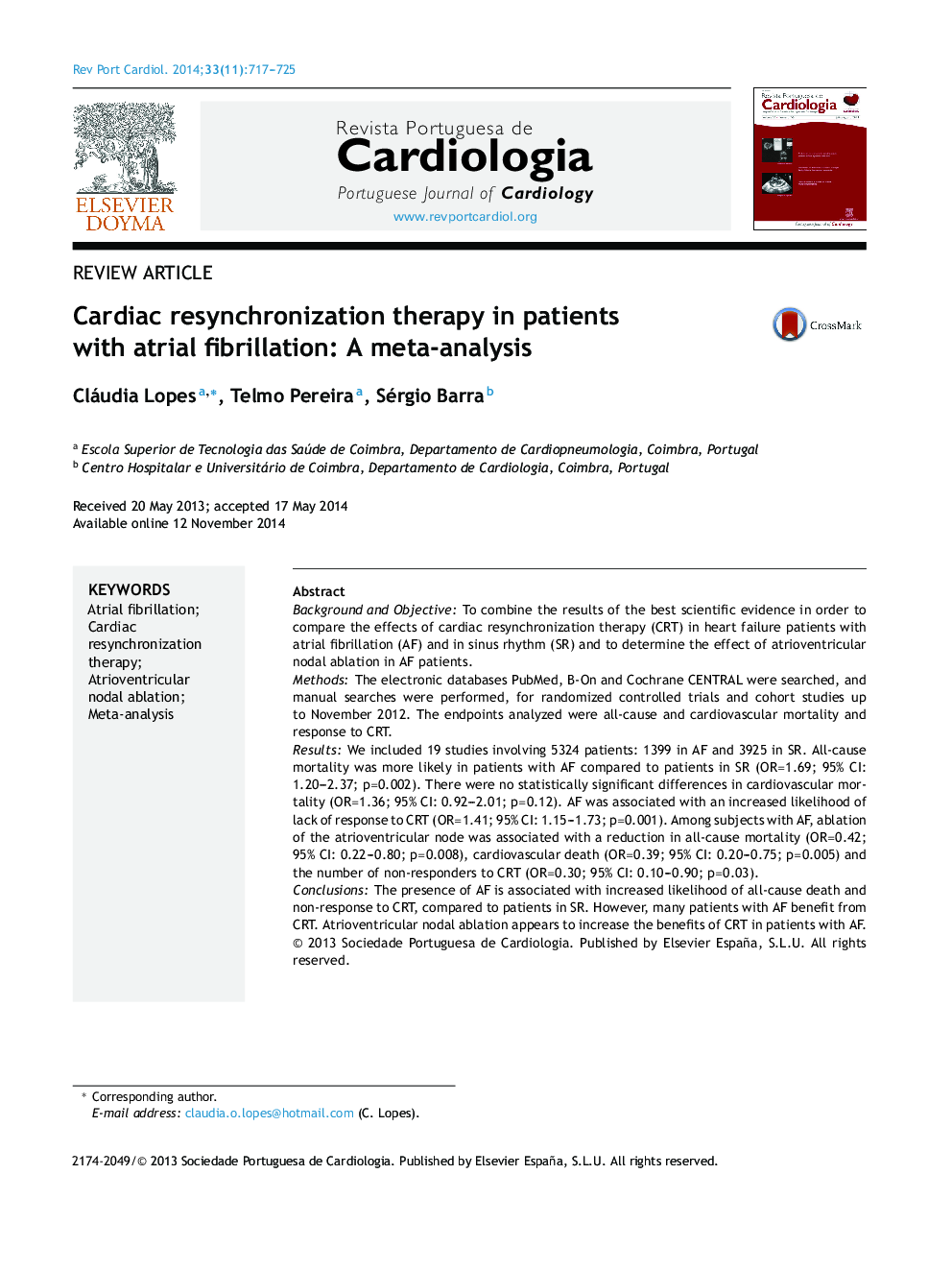| کد مقاله | کد نشریه | سال انتشار | مقاله انگلیسی | نسخه تمام متن |
|---|---|---|---|---|
| 3020164 | 1182290 | 2014 | 9 صفحه PDF | دانلود رایگان |
Background and ObjectiveTo combine the results of the best scientific evidence in order to compare the effects of cardiac resynchronization therapy (CRT) in heart failure patients with atrial fibrillation (AF) and in sinus rhythm (SR) and to determine the effect of atrioventricular nodal ablation in AF patients.MethodsThe electronic databases PubMed, B-On and Cochrane CENTRAL were searched, and manual searches were performed, for randomized controlled trials and cohort studies up to November 2012. The endpoints analyzed were all-cause and cardiovascular mortality and response to CRT.ResultsWe included 19 studies involving 5324 patients: 1399 in AF and 3925 in SR. All-cause mortality was more likely in patients with AF compared to patients in SR (OR=1.69; 95% CI: 1.20–2.37; p=0.002). There were no statistically significant differences in cardiovascular mortality (OR=1.36; 95% CI: 0.92–2.01; p=0.12). AF was associated with an increased likelihood of lack of response to CRT (OR=1.41; 95% CI: 1.15–1.73; p=0.001). Among subjects with AF, ablation of the atrioventricular node was associated with a reduction in all-cause mortality (OR=0.42; 95% CI: 0.22–0.80; p=0.008), cardiovascular death (OR=0.39; 95% CI: 0.20–0.75; p=0.005) and the number of non-responders to CRT (OR=0.30; 95% CI: 0.10–0.90; p=0.03).ConclusionsThe presence of AF is associated with increased likelihood of all-cause death and non-response to CRT, compared to patients in SR. However, many patients with AF benefit from CRT. Atrioventricular nodal ablation appears to increase the benefits of CRT in patients with AF.
ResumoIntrodução e objetivosCombinar os resultados da melhor evidência científica de forma a comparar os efeitos da terapêutica de ressincronização cardíaca (TRC) em doentes com insuficiência cardíaca em fibrilhação auricular (FA) e em ritmo sinusal (RS) e determinar a influência da ablação auriculoventricular (AV) no grupo de doentes em FA.MétodosA pesquisa realizou-se nas bases de dados eletrónicas da PubMed, B-On e CENTRAL e de forma manual, incluindo ensaios clínicos controlados aleatorizados e estudos de coorte até novembro de 2012. Analisou-se a mortalidade total e cardiovascular e a resposta à TRC.ResultadosForam incluídos 19 estudos que envolveram 5324 pacientes: 1399 em FA e 3925 em RS. O grupo com doentes em FA apresenta maior risco de mortalidade total, comparativamente ao grupo de doentes em RS (OR=1,69; IC 1,20–2,37, p=0,002). Não foram verificadas diferenças estatisticamente significativas quanto à mortalidade cardiovascular (OR=1,36, IC 0,92–2,01, p=0,12). A não resposta à TRC foi maior no grupo em FA (OR=1,41; IC 1,15–1,73; p=0,001). Entre os indivíduos em FA, a ablação do nódulo auriculoventricular foi associada à redução da mortalidade total (OR=0,42; IC 0,22–0,80; p=0,008), mortalidade cardiovascular (OR=0,39; IC 0,20–0,75; p=0,005) e número de não respondedores à TRC (OR=0,30; IC 0,10–0,90; p=0,03).ConclusõesA presença de FA está associada a maior probabilidade de morte por todas as causas e de não resposta à TRC, comparativamente aos doentes em RS. Contudo, um número significativo de doentes em FA beneficia da TRC. A ablação AV parece aumentar os benefícios da TRC nos doentes com FA.
Journal: Revista Portuguesa de Cardiologia (English Edition) - Volume 33, Issue 11, November 2014, Pages 717–725
